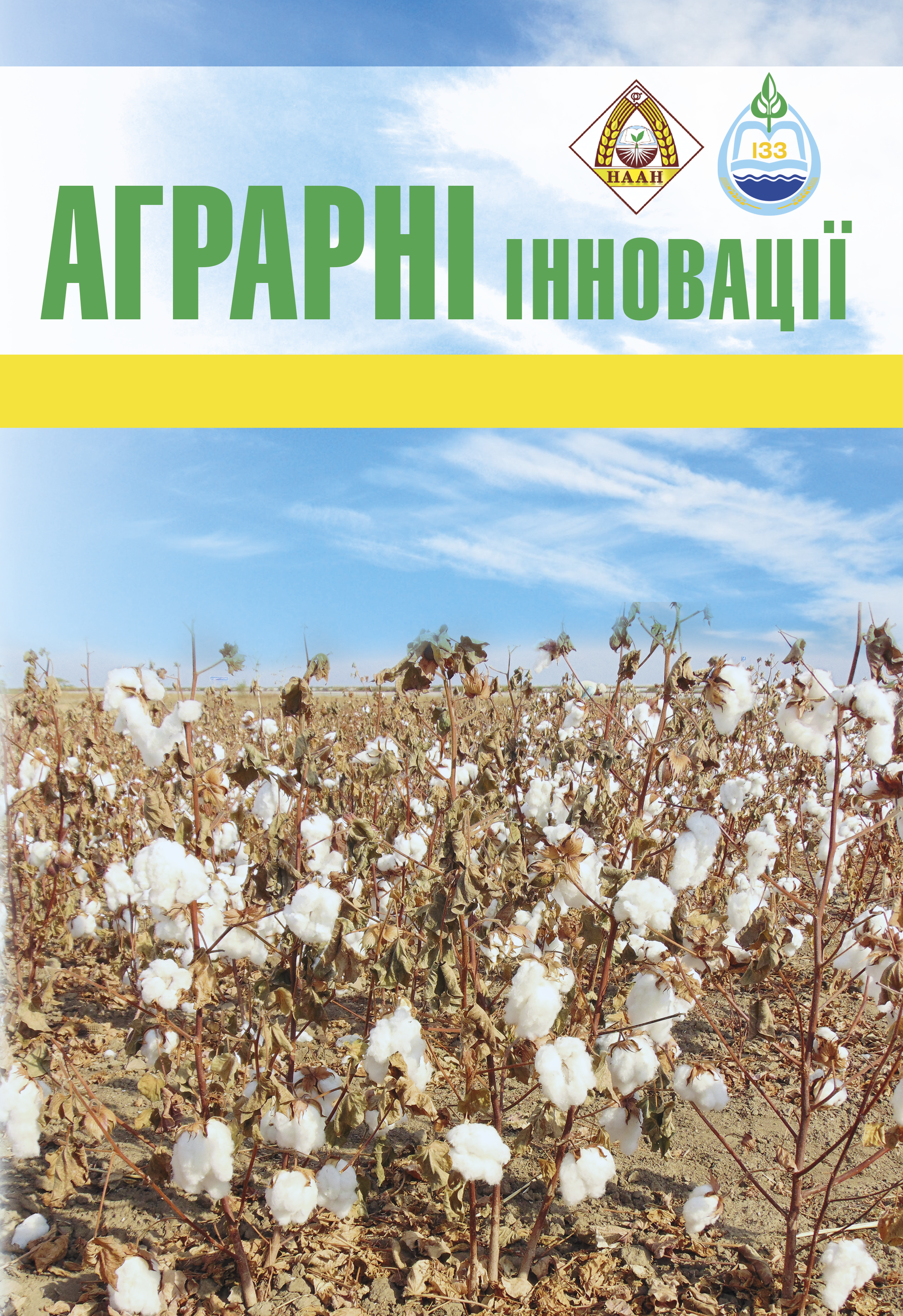The influence of spatial arrangement of crops relative to the forest on biochemical indicators of soybean grain
Abstract
The purpose of the article is to establish the patterns of influence of spatial distribution of soybean crops relative to forest plantations on the main biochemical indicators of seeds (moisture content, mass fraction of protein, nitrate content), in order to determine the optimal growing con- ditions of this crop to ensure its ecological and nutritional quality. Methods. The methodological basis of this research is: empirical (field experiments and observations; measure- ment of indicators of the research object; theoretical (put- ting forward a hypothesis and forming conclusions based on research results; statistical; mathematical. Results. The highest grain moisture content is 15.4% at a distance of 100 m; the lowest is 7.9% at 200 m. Remote areas have lower and more stable moisture levels (8–9%), while “medium” distances (100 m) have the maximum moisture level. This is explained by dynamic microclimatic conditions, less influ- ence of shading and regulation of water balance. A signifi- cant increase in protein content is observed with distance: from 40.2% (10 m) to 65.35% (1000 m). This is explained by increased lighting conditions and stress factor – the optimal environment in those areas promotes protein syn- thesis. Minimum values at 10 m: 15.1 mg/kg; maximum – 30.9 mg/kg at 200 m. With distance from the forest, nitrate accumulation increases due to potential excess fertilization, reduced natural filtration through buffer zones. Biochemical indicators of soybean grain specifically respond to the complex of climatic and ecological conditions formed by the forest buffer. Buffer proximity provides lower humidity and reduced nitrate accumulation, but may prevent the formation of optimal conditions for protein synthesis due to excessive shading. Optimal limits are 50–100 m for a more balanced indicator of the complex. 500–1000 m – well suited for grain with a high protein content, but require con- trol over nitrates. Conclusions. For the production of grain with low humidity and nitrates, it is better to plant fields in the zone 10–50 m from the forest. To obtain higher-class protein grain – 500–1000 m, but it is necessary to ensure environmental management of nitrate content. Introduction of buffer zones from green belts to limit pollution and pre- serve the optimal microenvironment.
References
2. Vradii O.I., Alieksieiev O.O. Ecological and economic assessment of the state of forest ecosystems in the conditions of marital state in Ukraine. Аграрні інновації. 2024. №27. С. 29–36. https://doi.org/10.32848/agrar.innov.2024.27.4
3. Врадій О.І., Салямон А.В. Вплив розташування лісів на агрохімічні показники родючості ґрунту в агроекосистемі. Український журнал природничих наук. 2024. № 9. С. 218-225. https://doi.org/10.32782/naturaljournal.9.2024.22
4. Врадій О.І., Салямон А.В. Екотоксикологічна оцінка грунтів агроекосистеми Лісостепу Правобережного. Таврійський науковий вісник. Серія: Сільськогосподарські науки. 2024. Вип. 138. С. 397–403. https://doi.org/10.32782/2226-0099.2024.138.47
5. Ткачук О.П., Врадій О.І. Параметри кореневих систем бобових багаторічних трав як чинник впливу на агроекологічний стан ґрунту. Екологічні науки. 2023. № 1 (46). C.153–161. https://doi.org/10.32846/2306-9716/2023.eco.1-46.25
6. Ткачук О.П., Врадій О.І. Баланс поживних речовин у ґрунті при вирощуванні зернобобових культур. Екологічні науки. 2022. № 2 (41). C.43–47. https://doi.org/10.32846/2306-9716/2022.eco.2-41.7
7. Vradii O., Mudrak H., Alieksieiev O. Application of biological preparations on the crops of perennial leguminous grasses as a means of providing soils with atmospheric nitrogen. In: Ecology, Biotechnology, Agriculture and Forestry in the 21st century: problems and solutions. Monograph. Edited by S. Stankevych, O. Mandych. Estonia. Tallinn: Teadmus OÜ, 2024. Р. 252–269.
8. Vradii O., Saliamon A. Influence of location of forests on agrochemical and toxicological indicators of soil fertility in agroecosystems. In: Agroecology, agriculture, forestry and horticulture in the 21st century: problems and solutions. Monograph. Edited by S. Stankevych, O. Mandych. Tallinn: Teadmus OÜ, 2025. Р. 139–154.
9. Pantsyreva H., Alieksieiev O., Tsyhanska O., Vradii O., Honchar M. Formation of qualitative indicators of chickpea seed production under climatic changes in the Right- Bank Forest-Steppe of Ukraine. International Journal of Ecosystems and Ecology Science (IJEES). 2025. Vol. 15 (2). P. 51–54. https://doi.org/10.31407/ijees15.207
10. Алєксєєв О.О., Мазур О.В. Формування та функціонування симбіотичної системи соя – Bradyrhizobium japonicum за умов бактеріальної і вірусної інфекцій в умовах Лісостепу правобережного: монографія. Вінниця: Видавництво ТОВ «Друк». 2023. 256 с.
11. Мазур В.А., Ткачук О.П., Панцирева Г.В., Купчук І.М. Соя в інтенсивному землеробстві: монографія. Вінниця: «Нілан-ЛТД». 2022. 220 с.
12. Алєксєєв О.О., Патика В.П. Формування високоефективної симбіотичної системи Bradyrhizobium japonicum – Соя. Тернопільський педагогічний університет ім. Володимира Гнатюка. 2014. С. 40-44.
13. Дідур І.М., Циганський В.І. Формування фотосинтетичної продуктивності посівів сої за біологізованої системи живлення. Сільське господарство та лісівництво. 2023. № 3 (30). С. 44-56.
14. Дідур І.М., Зюзько Л.Г. Накопичення та баланс азоту в ґрунті при вирощуванні сої в умовах Лісостепу правобережного. Таврійський науковий вісник. Серія: Сільськогосподарські науки. 2025. Вип. 141. Ч. 1. С. 72-77. https://doi.org/10.32782/2226-0099.2024.141.1.10
15. Дідур І.М., Зюзько Л.Г. Дослідження елементів технології вирощування сої (Glycine Max Moench) в умовах Лісостепу правобережного Аграрні інновації. 2025. № 29. С. 35-39. https://doi.org/10.32848/agrar.innov.2025.29.6
16. Заболотний Г.М., Пелех Л.В., Дідур В.В., Сорока С.Ю., Машенко В.В. Вплив оптимізації системи удобрення на формування фотосинтетичної продуктивності посівів сої. Сільське господарство та лісівництво. 2024. № 3 (34). С. 14-23.
17. Циганський В.І., Циганська О.І., Панцирева Г.В., Шевчук О.В. Накопичення біологічного азоту багаторічними бобовими травами та зернобобовими культурами як спосіб відновлення родючості ґрунту. Сільське господарство та лісівництво. 2025. № 1 (36). С. 16-27.
18. González E., Salvo A., Valladares G. Forest edges have differential effects on multiple ecosystem services in agricultural landscapes. Journal of Applied Ecology. 2020. Vol. 57(10). P. 1874–1884. DOI: 10.1111/1365-2664.13667
19. Дудка І.О. Вплив строків сівби та густоти стояння рослин на продуктивність сортів сої в умовах Лісостепу України. АгроСвіт. 2021. № 2. С. 32–36.
20. Шевчук В.Г., Поліщук І.С. Продуктивність сортів сої залежно від ширини міжрядь та норми висіву в умовах Правобережного Лісостепу. Вісник аграрної науки. 2020. № 8. С. 21–25.
21. Соловей С.С., Морозов П.В. Показники якості насіння сої в залежності від агротехнічних факторів. Збірник наукових праць Уманського НУС. 2022. Вип. 100. С. 111–118.
22. Кондратюк А.Ф., Ільчук М.М. Агроекологічна ефективність вирощування сої на фоні природно-кліматичних особливостей Центрального Лісостепу України. Агроекологічний журнал. 2021. № 3. С. 42–47.
23. FAO. Soybean production and quality in Ukraine: influence of agroecological zones. Rome: Food and Agriculture Organization of the United Nations, 2019. 48 p.
24. Наказ Міністерства аграрної політики України № 499 від 02.12.2020 «Про затвердження Методики визначення якості зерна сої». URL: https://zakon.rada.gov.ua/laws/show/z1462-20 (дата звернення: 26.02.2025 р.).
25. ДСТУ ISO 20483:2007. Зернові культури. Визначення вмісту азоту та розрахунок вмісту білка. К.: Держспоживстандарт України, 2007. 12 с.

This work is licensed under a Creative Commons Attribution 4.0 International License.






